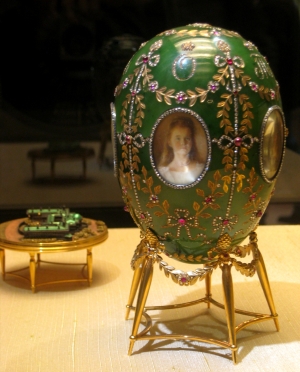Saturday 24 September 2016

Photo, left: The Alexander Palace Egg is a jewelled Easter egg made under the supervision of the Russian jeweler Peter Carl Fabergé in 1908, for the then Tsar of Russia, Nicholas II. Nicholas presented it as an Easter gift to his wife, Alexandra Fyodorovna. It is held in the Kremlin Armoury Museum in Moscow.
The Alexander Palace Egg is made of Siberian nephrite, diamonds, gold, rubies and miniature watercolor paintings on ivory. The outside of the egg contains five miniature watercolor portraits of the children of Nicholas II and Empress Alexandra: Olga, Tatiana, Maria, and Anastasia and the Tsarevitch Alexei. Above each portrait is a diamond monogrammed initial of each child's first name. On the reverse of each portrait, visible only from the inside of the egg, is the date of birth of each child, including Olga, November 3, 1895; Tatiana, May 29, 1897; Maria, June 14, 1899; Anastasia, June 5, 1901; Alexei, July 30, 1904. The remainder of the egg's surface is divided by five vertical lines, studded with diamonds and connected with one another by gold garlands inlaid with rose and ruby flowers. The dividing line between the upper and lower sections of the egg also has golden leaves, rubies and diamonds, together with two triangular diamonds with Alexandra's initials, AF.
The surprise is a detailed replica of the Alexander Palace, the Russian Imperial family's favorite residence in Tsarskoye Selo. The tiny replica also details the adjoining gardens of the palace. The miniature is made of tinted gold and enamel. The windows are made of rock crystal; the roo,f of enameled light green. The palace replica is placed on a gold table with five narrow high legs and can be removed from the egg. The base of the replica has an engraved inscription that reads, "The Palace at Tsarkoye Selo."
The Alexander Palace Egg was commissioned by Nicholas II in 1908 and presented to Alexandra. It was purchased for 12,300 rubles. From 1913 until 1916 it remained at the Alexander Palace in Alexandra Fedorovna’s Mauve Sitting Room 1913-1916. In 1917 it was confiscated by Kerensky's army during the Russian Revolution, along with many other Imperial treasures. It was transported from the Anichkov Palace to the Kremlin Armoury, where it remained. The Alexander Palace Egg is one of ten Faberge Eggs in the collection at the Kremlin Armoury, Moscow. Others include: Memory of Azov Egg (1881), Bouquet of Lilies Clock egg (1899), Trans-Siberian Railway egg (1900), Clover Leaf egg (1902), Moscow Kremlin egg (1906), Standart egg (1909), Alexander III Equestrian egg (1910), Romanov Tercentenary egg (1913), Steel Military egg (1916).
The stand is a replica of the original one, made in 1989 by the Moscow Experimental Jewellery Factory.
JOHN BATCHELOR SHOW
Hour One
Saturday 24 September 2016 / Hour 1, Block A: A Backpack, a Bear, and Eight Crates of Vodka: A Memoir, by Lev Golinkin (1 of 4)
Saturday 24 September 2016 / Hour 1, Block B: A Backpack, a Bear, and Eight Crates of Vodka: A Memoir, by Lev Golinkin (2 of 4)
Saturday 24 September 2016 / Hour 1, Block C: A Backpack, a Bear, and Eight Crates of Vodka: A Memoir, by Lev Golinkin (3 of 4)
Saturday 24 September 2016 / Hour 1, Block D: A Backpack, a Bear, and Eight Crates of Vodka: A Memoir, by Lev Golinkin (4 of 4)
Hour Two
Saturday 24 September 2016 / Hour 2, Block A: The Romanovs: 1613-1918, by Simon Sebag Montefiore (1 of 12)
Saturday 24 September 2016 / Hour 2, Block B: The Romanovs: 1613-1918, by Simon Sebag Montefiore (2 of 12)
Saturday 24 September 2016 / Hour 2, Block C: The Romanovs: 1613-1918, by Simon Sebag Montefiore (3 of 12)
Saturday 24 September 2016 / Hour 2, Block D: The Romanovs: 1613-1918, by Simon Sebag Montefiore (4 of 12)
Hour Three
Saturday 24 September 2016 / Hour 3, Block A: The Romanovs: 1613-1918, by Simon Sebag Montefiore (5 of 12)
Saturday 24 September 2016 / Hour 3, Block B: The Romanovs: 1613-1918, by Simon Sebag Montefiore (6 of 12)
Saturday 24 September 2016 / Hour 3, Block C: The Romanovs: 1613-1918, by Simon Sebag Montefiore (7 of 12)
Saturday 24 September 2016 / Hour 3, Block D: The Romanovs: 1613-1918, by Simon Sebag Montefiore (8 of 12)
Hour Four
Saturday 24 September 2016 / Hour 4, Block A: The Romanovs: 1613-1918, by Simon Sebag Montefiore (9 of 12)
Saturday 24 September 2016 / Hour 4, Block B: The Romanovs: 1613-1918, by Simon Sebag Montefiore (10 of 12)
Saturday 24 September 2016 / Hour 4, Block C: The Romanovs: 1613-1918, by Simon Sebag Montefiore (11 of 12)
Saturday 24 September 2016 / Hour 4, Block D: The Romanovs: 1613-1918, by Simon Sebag Montefiore (12 of 12)